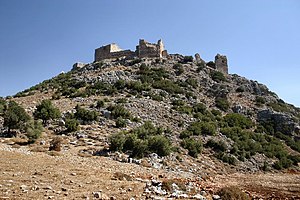Bourzey
| Bourzey | ||
|---|---|---|
|
Bourzey Castle, west side |
||
| Alternative name (s): | Qalʿat Marza, Qalʿat Barzuya, Rochefort, Lysias | |
| Creation time : | around 1103 | |
| Castle type : | Hilltop castle | |
| Conservation status: | ruin | |
| Geographical location | 35 ° 39 ′ 0 ″ N , 36 ° 15 ′ 0 ″ E | |
| Height: | 660 m | |
|
|
||
Bourzey ( Arabic قلعة برزويا, DMG Qalʿat Barzūyā , tooقلعة مرزة / Qalʿat Marza orقلعة ميرزا / Qalʿat Mīrzā ; French also Rochefort ; Latin .: Lysias ) is a crusader castle in Syria in the Latakia governorate . The castle ruins were essentially built by the crusaders . It was the last advanced defense post of the Crusaders in the east on the edge of the Ghab valley on the Orontes .
location
Bourzey is located about 25 kilometers south of Jisr asch-Shugur in the Ghab plain on a foothill on the eastern slope of the Jebel Aansariye , which drops steeply here from its highest point (near Slinfah ) 1000 meters.
Standing at the foot of the castle hill, the visitor does not immediately understand how the castle is accessible. The ascent is possible via a donkey path on the northern side of the mountain. There are 320 meters of altitude to overcome. From the high plateau with the abandoned village, keep to the south for the last 50 meters of altitude.
In August 2010 a road was built that leads up to the medieval village. From there you have to overcome about 50 meters in altitude to get to the ruins. The castle is freely accessible.
history
The castle hill played a role in securing the connection between the cities of Laodicea ( Latakia ) and Apamea from the Seleucid period under the ancient name of Lysias . The Roman general Pompey drove out around 65 BC. Chr. Jewish partisans from the fixture.
Later the Byzantines built a fort on the mountain. In 948/949 the commander Abu al-Hagar took the castle on behalf of the Emir of Aleppo , Saif ad-Dawla . In 975 the Byzantine general Tzimiskis recaptured the castle from the Hamdanids in Aleppo. After the Battle of Mantzikert in 1071, the Muslims regained the upper hand in northern Syria. Al-Dawla Aqsunqur , the Seljuk governor of Aleppo, took possession of the castle in May 1090. Around 1103 crusaders from the Principality of Antioch took the fortification. On the basis of comparisons in construction technology and style, it can be determined that the structures that still exist today were built by the Crusaders in the first phase of the castle construction (1100–1140).
On August 23, 1188, Saladin took the castle during his campaign after the battle of Hattin . He had besieged the castle since August 20, 1188. It had a reputation for being invincible because it was impossible to bring siege devices close to its walls. Saladin really failed to get the machines into effective distance. Thereupon he had his troops divided into three units, which ran into successive waves again and again against the western wall. So he exhausted the weak strength of the defenders. Eventually the garrison capitulated under pressure from Saladin's military strength. The castle garrison was also allegedly demoralized by the fact that the castle commandant's sister-in-law kept revealing the secrets of the Franks to Saladin.
Saladin could not keep the castle under his control permanently. Soon the castle was occupied by the Crusaders again and played an important role in the defense system of the Principality of Antioch.
literature
- Jean Mesqui: Forteresses Médiévales au proche-orient, Quatre châteaux des Hospitaliers au nord du comté deTripoli perso.wanadoo.fr/jmsat.mesqui/1-Hospitaliers/ pdf / avant_propos.pdf
- Ross Burns: Monuments of Syria . IB Tauris Publishers. London / New York, 1999
- Baedeker Syria . Karl Baedeker publishing house. 2000
- Walter Zöllner: History of the Crusades . VEB German publishing house of the sciences. Berlin 1983
- Wolfgang Müller-Wiener: Castles of the crusaders in the holy land . German art publisher. Munich 1966
- Robin Fedden, John Thompson: Crusader castles in the Holy Land
- Th. E. Lawrence: Crusader Castles . Revised edition. Oxford 1989
- Hugh Kennedy: Crusader castles . Cambridge University Press, 1995
- Thomas Biller: Castles in the Crusader States - from aristocratic residence to "fortress" In: Castles and palaces in Saxony Anhalt . Issue 1. Halle / Saale 1992




